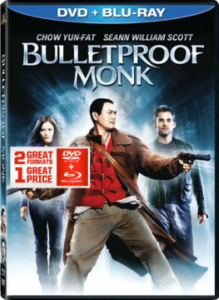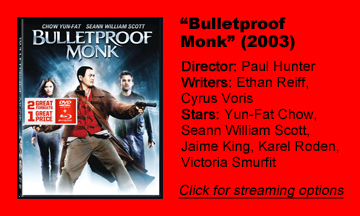“Bulletproof Monk” (2003), based on a comic so obscure that it doesn’t have a Wikipedia page, was overlooked upon its release because it appeared to be a second-rate Chow Yun-Fat picture with a toned-down version of Stifler as his sidekick. It’s overlooked today because there are so many better superhero movies. But there are far worse ones, too.
Invisible wire work
Directed by music-video veteran Paul Hunter, “Bulletproof Monk” probably felt like more of a commercial cash-in at the time than it does today. Chow burst onto the international scene with “Crouching Tiger, Hidden Dragon” in 2000, and “Bulletproof” likewise uses invisible wire work that scoffs at gravity.
This action style – seen in everything from “The Matrix” to “Charlie’s Angels” at the turn of the millennium — is less ubiquitous today, so it’s easier to go with the film’s tenuous explanation that meditation can help a martial artist float on the air.
Everyone loved Seann William Scott as sex-crazed Stifler in 1999’s “American Pie,” and here he plays a slightly less self-centered guy, although Kar does start off as a pickpocket.
Writers Ethan Reiff and Cyrus Voris essentially pen a children’s action movie about morality, although there’s too much violence to recommend this for younger kids.
The monk, often smirking with his eyes, is nameless and ageless in addition to being bulletproof. He’s seen too much to get worked up about anything, but he does take seriously a trio of prophecies involving the handoff of his job of protecting an ancient scroll.
When two of the prophecies seemingly point to Kar and Jade (Jaime King), he wonders if “two out of three” is good enough. The film doesn’t make fun of Buddhist philosophy, but it takes an all-in-good-fun approach to it.
Villains from history books
“Bulletproof” came out at the tail end of the era when Nazis could be villains in a contemporary piece, as they are now too old. Karel Roden’s Strucker is an elderly Nazi who has been pursuing the monk for 60 years since he escaped his clutches in Tibet during World War II.
Scott and Chow – and later, King — have good chemistry as their characters’ worlds collide and mesh in New York City. Although it’s easy to call Scott “Stifler,” we don’t think of that “American Pie” icon when watching this.
The actor has his unmistakable goofy grin, but he tones down his shtick to become likeable and plausible as an action star (something he’d eventually parlay into a role in the “Lethal Weapon” TV series). In 2003, I would’ve guessed King was on her way to the A-list; still, she’s had a nice career, notably voicing Aurra Sing on “Star Wars: The Clone Wars.”
But the most enjoyable part of the film is how it looks. Cinematographer Stefan Czapsky captures Toronto’s old-world brick architecture and infrastructure as stand-ins for New York City. When Kar isn’t picking pockets, he works at an old movie theater that screens Asian martial-arts films. He lives above it in an evocatively messy loft.

Little sense of peril
The fights against Strucker and his minions are superficially engaging, but there’s no real sense that the monk can be harmed (he is bulletproof after all). A highlight is when the monk hangs beneath a helicopter. To dodge an enemy who leans out, he does a gymnastics swing to the other side of the landing gear and sneaks up on the guy from behind.
While Kar and Jade can be hurt, this is the type of movie where we doubt they really will be. That said, there is enough violence here toward supporting characters that it’s not quite a family friendly film.
Indeed, “Bulletproof Monk” is caught in the middle in a lot of ways – derivative, but not without its own source material. It came out at the end of the gravity-defying martial arts era, but before the height of the superhero boom. It has Scott and Chow, but both are toned down from their showier roles.
Overlooking “Bulletproof Monk” won’t leave a hole in your knowledge of cinema history, but if you come across it in an effort to watch every superhero film, it will be a mostly painless assignment.


